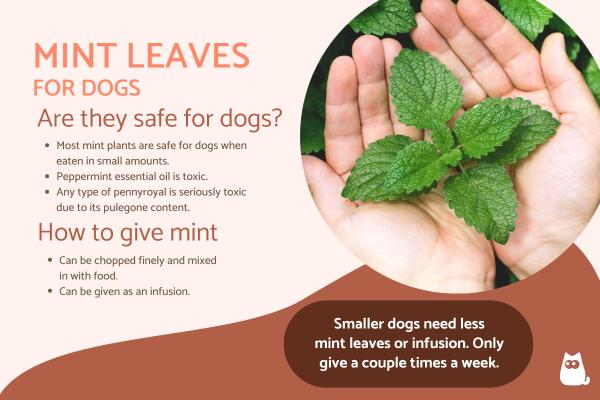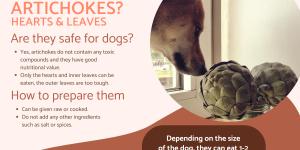Can Dogs Eat Mint Leaves?



See files for Dogs
Whether dogs can have mint will depend on the type of mint species, since not all are the same. generally speaking, mint leaves are safe for dogs, but this will depend on how they are consumed. Due to their strong flavor and not being part of a dog's natural diet, mint leaves may not be particularly appealing to dogs. Some guardians may consider giving mint leaf tea infusion to dogs, hoping they provide certain benefits for digestion. Many different products use mint flavorings, but this is not the same as fresh mint leaves. This is why AnimalWised asks can dogs eat mint leaves? In answering the question, we find the types of mint leaves dogs can and can't have, as well as the best way to provide them to dogs.
Are mint leaves bad for dogs?
Mint belongs to the genus of perennial herbaceous plants called Mentha, which is part of the Lamiaceae family. The exact number of mint species is not known, but it could be anywhere up to 24, if we do not include hybridizations. Dogs can eat most mint leaves from species such as spearmint (Mentha spicata) and wild mint (Mentha arvensis).
Although most mint leaves are safe for dogs, there is one which needs to be avoided at all costs:
- Pennyroyal (Mentha pulegium)
Pennyroyal is a type of mint plant which can be drunk as an infusion by humans, but never by dogs. This is because it contains the compound pulegone. Even in humans, drinking pennyroyal tea needs to be limited. It is highly toxic in dogs and any form or preparation needs to be avoided, including its fresh leaves.
Another important factor to consider is the essential oils derived from mint leaves. In general, most mint leaf essential oils will not be toxic, although damage will occur if they eat too much of any essential oil. Peppermint (Mentha × piperita) is an exception as its essential oil is toxic to dogs and ingestion can result in serious gastrointestinal problems. As a general rule, mint essential oils should be avoided.
Learn about what other plants and foods canines cannot eat with our article on forbidden food for dogs.
Can dogs eat mint candy or gum?
Natural mint is not the same as mint candy or other mint flavored confections. While its natural flavor may be derived from fresh mint leaves originally, this flavor is most often derived artificially. Not only are the artificial flavors themselves potentially harmful to dogs, other additives can be highly toxic.
An example of a toxic compound often found in mint candy or chewing gum is xylitol. Xylitol is a sweetener that can cause problems related to the rapid release of insulin in dogs, triggering clinical signs derived from a drop in blood sugar or hypoglycemia. In addition, the xylitol present in these sweets or chewing gums can cause severe liver necrosis in our dogs, since the liver is the main organ that metabolizes this substance.
Even candy which has no artificial flavors or additives will be bad for dogs. This is because it contains sugar which should be avoided at all costs. Regardless of flavor, no gum should be given to dogs. Gum is not meant to be ingested and the dog will not know to chew it instead of swallow.
Learn more about the effects of eating too much sugar with our article on diabetes mellitus in dogs.
Benefits of mint for dogs
For humans, mint consumption is widespread and its health benefits have been better studied than in veterinary medicine. These benefits will also depend on the type and method of preparation. While the dog will not likely eat mint leaves on their own, an infusion can be made and given to the dog. When given this way, the benefits may include:
- Digestive support: may be helpful in relieving mild indigestion or even mild nausea.
- Antioxidant properties: may help with oxidative stress, but evidence in dogs is lacking.
- Mild anti-inflammatory effects: certain compounds may help promote general well-being.
If they are able to tolerate eating fresh mint leaves, they may be used to help freshen the dog's breath. It is very important to know that the benefits of mint for dogs are poorly known. Its use can be supplemental to other treatments, but it is never a replacement for veterinary treatment. Ensure you speak to a veterinarian before giving any type of mint to your dog.
How to give mint to my dog
The best way to give fresh mint leaves to your dog is to mix them into their food once finely chopped. Offering whole mint leaves to the dog can cause them to reject the plant. Don't forget to wash the leaves well beforehand.
In addition, the introduction should be gradual, starting with minimal amounts to observe the dog's body's reactions to the mint. Another option is to prepare an infusion.

Amount of mint for dogs
You should never offer mint to your dog too often. Even if it is a completely safe type of mint, the dog may suffer abdominal pain with symptoms such as diarrhea and vomiting if they consume too much. So, if you are wondering how much mint is safe for dogs, use the guide below:
- Small or miniature dogs: one leaf or less per day.
- Medium dogs: two leaves at most per day.
- Large dogs: a little more than two leaves a day, but no more than three.
For a mint tea infusion, place a spring of mint in a cup of boiling water and leave to infuse. Let it cool to room temperature before giving to the dog. A small dog can be given 1 teaspoon, a medium dog 1-2 teaspoons and large dogs 1 tablespoon. Don't give more than once or twice a week.
Side effects of mint for dogs
We have previously discussed that peppermint when consumed in high amounts can cause stomach upset, vomiting, and diarrhea. Other effects resulting from excessive peppermint consumption in dogs include seizures, bloating, anorexia and balance problems.
When mint is consumed in the form of candy or chewing gum containing xylitol, serious side effects can occur. In particular, if a dog consumes a mint preparation containing a dose greater than 0.1 g/kg of xylitol, they can suffer from hypoglycemia. If the amount of xylitol consumed exceeds 0.5 g/kg, liver necrosis can occur which leads to liver failure with symptoms such as tremors, depression, seizures and incoordination.
Liver damage in dogs can appear up to 72 hours after ingestion of the sweetener, even if there has been no previous hypoglycemia. In the worst cases, the dog that has consumed xylitol from a mint candy can die.
Learn about what happens if a dog eats other foods which are toxic to them in our article on garlic and onion poisoning in dogs.

Contraindications of mint for dogs
Mint should not be consumed by dogs in large quantities. Excessive consumption can cause gastrointestinal effects such as vomiting, diarrhea, indigestion and abdominal pain. Another contraindication to keep in mind regarding the consumption of mint by our dogs is to avoid offering it to them in the form of preparations, chewing gum or sweets that contain it. Especially if they are sweetened with sweeteners such as xylitol, it can result in serious side effects.
In addition to pennyroyal, discover the different types of plants toxic to dogs in our related guide.

If you want to read similar articles to Can Dogs Eat Mint Leaves?, we recommend you visit our Homemade diets category.







